|
The Rushden Echo and Argus, 16th May, 1947, transcribed by Gill Hollis
New House and Baby in the Same Week
Completion on Wednesday evening of the first four houses erected by Rushden Urban Council on the estate which is approached from the far end of the town also coincided almost to the day with arrival of a very new occupant-to-be of the second house. [The first column of this article is on the fold of the page and is unreadable]
Now that the Council had made an excellent start on the estate he hoped the whole of the estate would be finished by the end of 1947. Though he was not so sanguine as Coun. Weale over the 600 applicants, he hoped progress would continue.
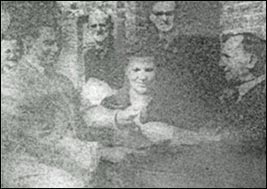 |
|
Coun. A. F. Weale, last year’s Chairman of the Housing Committee of Rushden Urban Council, presents the keys to Mr. A. R. Keys, a new tenant of one of the first four permanent Council houses opened yesterday. Mrs. Keys (centre) watches the ceremony.
|
The first tenants entered their new house and invited the chairman of the Council and others to enter and inspect for themselves.
The future tenants of the four houses expressed themselves delighted with the homes, and there were many expressions of admiration and envy from others who flocked in to view the first house – that now reserved for Mr. and Mrs. A. R. Keys.
This couple, who have three children, hope to move in about Monday. They were very pleased with all facilities and the pleasant airiness of the rooms.
Green and cream is the outside colour scheme and these colours, with brown are used indoors. The kitchen and bathroom are the outstanding features of a thoroughly attractive and well planned building.
Cupboard Space
Plenty of cupboard space is the feature of the kitchen, with green and cream predominating. A deep sink, with hot and cold water taps, is encased by drawers and cupboards, one of which contains the copper. A folding table is attached to one wall and a French door (Almarco metal, like the windows) leads out on to the outbuildings, one of which is a “spare,” suitable for bicycles or a pram.
In the living room there is an Ideal domestic boiler. A gas poker is supplied, and there is a radio point in each room.
In the hall there is a generous sized fixed clothes runner, and cupboard with gas and electric meters (quarterly) enclosed. Another interesting feature is a three-tier safety catch receptacle for milk, bread, etc.
Upstairs, there are three bedrooms, a bathroom, and an airing cupboard on the landing. The colour scheme of the bedrooms is carried out in two shades of cream, and all have built-in wardrobes. One of the rooms has a blue tiled grate, and another a wall electric fire. The “spare” room is large enough to contain a single bed.
The bathroom is an excellent feature of the home, with bath, wash-basin (both with hot and cold water taps), and lavatory. There is a glass shelf over the washbasin.
A much needed facility in English homes – a snow guard surrounding the house tops – has not been overlooked.
|
The Rushden Echo and Argus, 6th June, 1947, transcribed by Gill Hollis
Avenue Leads to “Progress Estate”
Prospect Avenue, Rushden, now leads to what should be called “Progress Estate” – major bright spot on the local building horizon. “Very, very nice,” “delightful,” “perfectly satisfactory,” are a few of the superlatives fired at an “Echo and Argus” reporter who went to see what the new tenants think of the first permanent council houses built in the area since the war.
Visit “Progress Estate” and you will see what, in the opinion of young people, Council houses should really be like.
At the Rushden end of the estate – for it includes both Rushden and Higham Ferrers areas – bright airy back-rooms look out over the green open fields beyond the railway. “Everything for convenience,” is the motto. Gas, electricity, hot and cold water – and sunlight – are all laid on.
See what Mrs. R. Keys, who has been in her house three weeks and was among the first residents on the estate, thinks of her new house. “Very, very nice,” she says. “Everything for your own convenience. We should be pleased. I think they are a terrific success.”
Mr. Keys is a musician, who played in Copenhagen before the war. “We would have liked to have gone there,” said his cheerful wife, as she proudly showed the reporter round her spotless rooms. But we are quite happy now.”
There are three children at No. 2 – Roger (7), Sandra (4½), and Pauline (3½).
And what does little fair-haired Pauline, who was playing in the garden in a green-flower sun-suit, think of all this? “Very nicely, thank you,” she says sweetly.
“These are just like sunshine houses. One can get up with the sun and breeze coming through the window,” added Mrs. Keys.
She tells how Roger suffered from asthma in the old house near Spencer Park, being low-lying, was rather damp and cold. He has only had the trouble once since they arrived on the estate – and after he revisited the old home.
Never So Happy Before.
Next door but one lives Mrs. H. R. Cross, whose husband is a clicker for Messrs. John White. Mrs. Cross has two children, Anita Victoria, born on V. E. Day, and ten weeks old Paul Raymond, who was sunbathing in his pram outside the back door.
“We have never been so happy in our lives,” said Mrs. Cross. “My husband has to keep pinching himself to make sure that it isn’t a dream.” That is what this couple think of their home – the home for which they have waited six years, since the time of their marriage.
Go along the newly-built concrete road to the other end of the estate, and within the boundaries of Higham Ferrers; not far from the old church, you will find four more houses occupied.
“Very happy” Mr. and Mrs. F. R. Moore moved in on Friday, and soon found that young Royston preferred his new home to the old one in Roland-avenue. “We can never find him when we want him,” said Mrs. Moore. “He’s always talking to the workmen. He loves it round here.”
That was (not unlucky) 13, and at 17 lives Mrs. John Connolly, whose husband at the moment is working for Messrs. Taylor Woodrow at Bournemouth.
“I think all working-class people should have homes like this.” said Mrs. Connolly. “Council houses like this will cut out private houses.”
We met Mrs. Connolly at her mother’s (63, High-street), where she was busy helping to spring clean the room that she and her husband had occupied since they were married in 1942. When twins, now aged four, and 20 months’ old little Rita came along, there was not enough room, explained Mrs. Connolly.
“It’s beautiful, it’s lovely. There is the country smell of the farm. The air’s so fresh that it gets you tired,” she burst out.
One of those little things that mean a lot to Mrs. Connolly is the path which leads straight to her mother’s back door. “Handcross-way,” she mused – “it should be Handycross-way.”
Readers in old-fashioned quarters may wonder what makes these householders so happy.
Here is a brief description of the houses.
Wardrobes Are Built In.
Those completed are built in blocks of four. Tastefully decorated inside, mainly with creams and greens, they have adequate kitchen accommodation for pots and pans, a gas copper, which draws out from inside a cupboard. Cooking is by gas, though some householders may have electric cookers fitted. There is hot and cold water, the hot water being contained in a boiler in an upstairs airing cupboard.
What most thrill the housewives are the built-in wardrobes in every bedroom. “We have so much room, I never know where I have put everything,” said one of them.
Striking innovation in some of the houses on the estate is an automatically locking three-shelved steel cupboard near the front door for the use of local tradesmen. There they can leave their wares out of the way of road dust. Another innovation in some houses is a fitting beside each fireplace for a gas poker (used for lighting fires).
There are three rooms upstairs and two rooms and a kitchen below. Electric plugs are fitted at handy spots throughout the house.
And in wet weather, or when it is too cold for baby to be outside in the neat little garden, she can be placed in the fresh air under a glass-roofed space between the house and the handy-sized outhouse.
To-day the whole of the site is a major industrial project, and every kind of workman is hammering or sawing away as fast as materials arrive – which is, of course, not quite as fast as local Council officials would like.
All day there is a constant stream of workmen and lorries on the concrete roads, a stream to be replaced every Sunday by a throng of prospective householders bent on inspecting their future homes.
Messrs. M. M. Drabble, Ltd. have about 50 labourers and builders with almost as many allied craftsmen at work. They have 24 houses roofed at Rushden and 22 at Higham. Messrs. R. Marriott have 24 houses roofed. Altogether 52 houses on the Rushden side are under construction, and contracts for 30 more have been let.
Footnote: Erection of sixty-six “Trusteel” houses has now been commenced on the Newton-road estate.
|
Rushden Echo & Argus, 13th February 1948, transcribed by Kay Collins
Economy in housing has been enforced by the Ministry of Health. It was reported that the Council could invite tenders for not more than 25 houses at present, and that the layout plan of the remaining portion of the Higham Road estate has been adjusted so that houses are built in blocks of four or six instead of in pairs.
After receiving this report, the council agreed to accept tenders for 24 houses.
Shrubs and trees are to be planted on the estate.
|
Rushden Echo, 27th February & 12th March 1948, transcribed by Kay Collins
More Houses to Go Up Soon
Rushden’s first post-war estate of 128 houses is soon to be completed.
Coun. T. W. Cox told the Council on Wednesday that the next batch of 24 houses on the Higham Road estate will cost £31,500. In addition to these the Council has now been authorised to build 24 houses which will complete the estate.
A revised scheme for the construction of footpaths on the Higham Road estate by district labour at a cost of £3,800 has been approved. The work will be done in instalments beginning at “The Hedges”.
Another footpath scheme is to be submitted to the Ministry of Health. It is for the Truseel Estate off Hove Road and may cost £2,558.
A street name is required for the cul-de-sac off Hove Road and the Housing Committee will be pleased to receive suggestions. A statement on council house rents showed that no variation is proposed on the net rents at present charged. The rent of the Trusteel houses will be 11s. per week net.
Coun. Capon said this report might be misunderstood. It should be emphasised that the tenants had to pay 11s. a week plus rates.
|
The Rushden Echo and Argus, 22nd April 1949, transcribed by Gill Hollis
Canaries Raise a Storm - Kept in Bedroom, Council Objects
Having been refused permission to put an aviary in his garden, a tenant of Rushden Urban Council may now be served with notice to quit because he keeps his canaries in a bedroom.
Protests were raised at last week’s meeting, however, before the Council confirmed the Housing Committee’s report. This said the tenant (Mr. G. Cooper, of St. James Close) still kept birds in a bedroom in spite of requests that he should move them. It was proposed that he should be given notice unless he discontinued the practice within 14 days.
Councillor J. Allen, moving the reference back of the minute, said that such extreme steps were unnecessary in so trivial a matter. The tenant had proposed to keep the birds in a properly constructed garden aviary to which the former Surveyor had no objection, but the Council would not allow this.
The Council would have a very flimsy case to take to the County Court, continued Mr. Allen. The conditions of tenancy stated that no animals were to be kept without the permission of the Housing Manager. There was also a condition against poultry – which was more honoured in the breach than in the observance – and pigeons, but nothing was said about smaller birds.
Big Blunder
“I think we are out to make a big blunder if we take this to the final conclusion. This man has a reasonable and intelligent hobby which he wishes to pursue, and I don’t know of any private landlord who would not allow it.”
Councillor J. Roe, who seconded the amendment, said they were treating the tenant rather harshly.
In reply to Councillor A. H. Bailey, who suggested that there might be some later information, the Clerk (Mr. A. G. Crowdy) said the tenant had given him a verbal assurance that he would take the cages out of the bedroom and keep them in the outbuildings.
Councillor Allen: Why was not this information given to us by the chairman of the Housing Committee?
Councillor J. H. J. Paragreen (presiding): I don’t know whether he knew this.
“Talk about a storm in a teacup,” retorted Councillor J. T. Richardson, the Housing Committee chairman; “we’ve certainly got it now. It is no light thing to have 500 people come and tell you that they are sleeping in terrible conditions when you know that a bedroom is being used in this way.”
Only three members voted for the amendment and the report was then adopted.
|
The Rushden Echo and Argus, 26th October, 1951, transcribed by Jim Hollis
Recreation catered for near homes
If juvenile enthusiasm can be accepted as sufficient reward, then the development of the first playground in conjunction with a Rushden Council housing estate is proving a huge success at Tollbar – just off Higham Road and to the rear of Prospect Avenue.
An oblong area about 200 feet by 400 feet, it is securely enclosed away from the main streets of the town’s first completed post-war estate and already boasts two sets of swings, a see-saw and a roundabout.
When a reporter and photographer arrived just after three one sunny afternoon this week, the playground was deserted except for a pair of four-year-olds exercising their dog. They, however, promised results as soon as the “big ‘uns” got out of school.
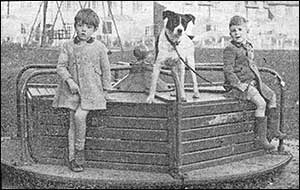 |
|
Two boys, a dog and a roundabout - on the “Tollbar” playing ground —the first developed in conjunction with a Council housing estate.
|
Their prophecy was quite correct. Within a few minutes of the infants’ school at Higham Ferrers closing for the day the “big ‘uns” began to arrive, snugly protected against the biting wind in pixie hoods and scarves; several clutching buns and biscuits garnered from the tea-tables en route.
Strategy
Six-year old Diane Timpson, of 50, St. James’ Close, a blonde sporting a green satin hair bow, was the spokesman for the first arrivals. “We like it very much,” she said. She added the information that when the scholars from the “big school” turned out at four o’clock the playground quickly filled up.
The earliest arrivals obviously knew what they were about, because if they left the swings for a whirl on the roundabout a companion always took and guarded the vacated seat.
Speaking for the parents of the new estate, Mr. G. Anderson, of 15, The Hedges, whose three children, Georgina (7), Cathie (2) and Stuart (5), were among the first arrivals, said they were very enthusiastic about the playground. He and his wife had accompanied their offspring to the swings as part of the everyday routine.
And the playground serves not only for amusement, but as a community centre too. A gigantic bonfire is in the making in its centre, and on November 5th the estate dwellers intend to make one big show of their fireworks collections rather than have mediocre individual displays.
|
The Rushden Echo and Argus, 28th March 1952, transcribed by Gill Hollis
Parents demand school transport
Fifty mothers who live on the Higham Road estate, Rushden, and who are concerned about the safety of their children, will be signing a petition this week. They are campaigning for a special bus to take their infant children to and from Alfred Street School, which is a mile distant.
At present about 20 children are making the journey daily, but when the September term commences there will be an additional 30.
Parents are worried about several things under the present circumstances. Their children have to stay away from home all day – too long for tiny tots, they say – and they often experience difficulty in getting on the buses both going to and returning from school.
Then there is the fact that when the children alight from the bus in Rushden they have to cross the towns busiest thoroughfare to get to school.
Expense
Finally there is the matter of expense. It costs a good deal of money to accompany a child to school by bus every day in addition to the money required for school dinners.
Instance of this can be found in the case of Mrs. A. Silsby. She has two children at Alfred Street School at a weekly cost of 8s 4d. This is made up of school dinners for two (5s 10d) and bus fares (2s 6d).
Most parents would rather send their children to Higham Ferrers School, which is nearer. Some children from the estate already attend at Higham, but it is now compulsory for them to be sent to Rushden.
Women behind the petition are Mrs. D. Fields and Mrs. J. Dodson, both of St. James’ Close. During the past few days they have visited more than fifty houses to ascertain the general feeling of parents. Both have children who will start school in September.
|
 The Rushden Echo and Argus, 18th July 1952, transcribed by Gill Hollis The Rushden Echo and Argus, 18th July 1952, transcribed by Gill Hollis
Damage by Poplars - Tree Menace at Tollbar
Timber bracing on a new Rushden Council house at Tollbar has caused considerable speculation among local people. Many believe that the bracing is holding the house up. It is in fact a precautionary measure while workmen are digging under the foundations to pour in concrete. Reason for the subsidence of the foundation is thought to be the nearby poplar trees which have drawn all the moisture out of the ground. Inside the house where Mr and Mrs F Griffiths and their two small daughters live, ever widening cracks have been appearing in the walls of every room for the last six months.
|
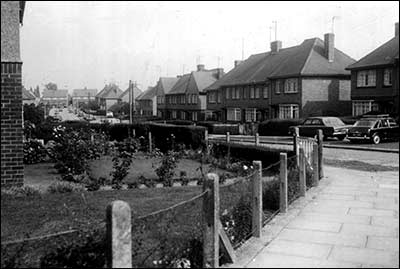 |
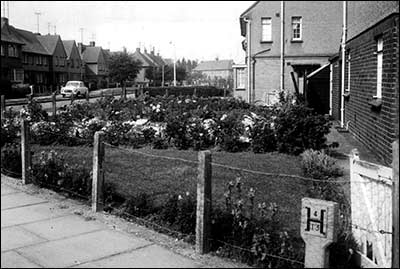 |
|
The Hedges looking up to the Higham Ferrers end c1962
|
Looking along St James' Close from The Hedges c1962
|
| Memories - Most of the families who first moved onto this estate were of the men who returned after the second world war. The first children who lived here went to Higham Ferrers school, but after a few years only those with a sibling already at the school could go, the others went to Alfred Street.
The roads were Handcross Way, The Hedges and Tollbar which all straddled the boundary of the two parishes of Rushden & Higham Ferrers. St James' Close was wholely in Rushden parish and was named after the ancient hospital which had once been there, and Tenter Close was wholely in Higham parish. The estate had two leisure areas; a recreation ground with swings, roundabout, slide and large grass area for ball games, behind the gardens of the St James' and The Hedges houses (nearest to Prospect Avenue), and a large grassed area bounded by Handcross Way and Tollbar. KC
|
|
Rushden Echo, 8th July 1955, transcribed by Jim Hollis
Part of the ‘Spotlight on Rushden’ series
Parents hire school bus
So worried were parents on the Tollbar Estate about the hazards of their children’s walk into Rushden school that at their own expense they are providing a school bus. A specially chartered double-decker makes five journeys a day between Rushden and the Tollbar.
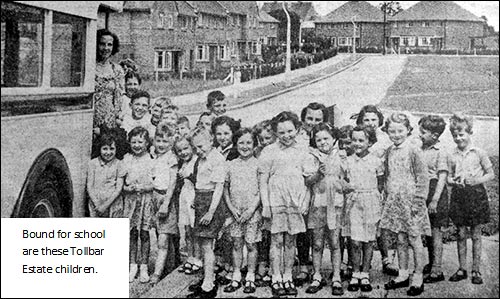 |
| It’s a dangerous road down into town, and so the parents are providing a daily bus at their own expense. Five collectors cover the Rushden part of the estate, and the cost is half-a-crown a week per child. |
The estate is within the official “walking distance” to school, so that a bus cannot be provided by the education authority.
First the parents engaged a small bus to carry thirty to forty children, but now the number of youngsters has increased to eighty, and a double-decker is needed.
The bus makes five trips a day – two in the morning to fetch and return the children, and three in the afternoon because infants and juniors finish at different times.
Each parent pays half a crown a week for each child using the bus, and five of the mothers act as voluntary collectors.
The money is handed to Mrs. Edith Reynolds, who acts as treasurer and pays for the bus.
Cost of the bus is ten guineas a week, says Mrs. Reynolds, whose six-year-old daughter Linda is one of the regular passengers.
No Ride, No Fare
“We keep a week’s payment in hand in case of epidemics, because if the children do not use the bus, they do not have to pay.”
This week, for example, the number of young passengers was less than usual because of some cases of chicken pox.
Parents on Tollbar Estate regard their bus scheme as a blessing, for it ensures their children safe travel through the busy Rushden streets at a cost of only three-halfpence a journey.
Newton Road is “crammed” and Alfred Street “filled to the limit.”
|
|